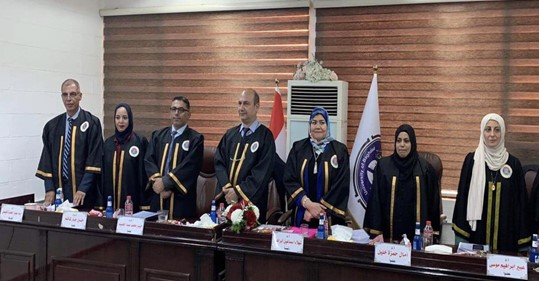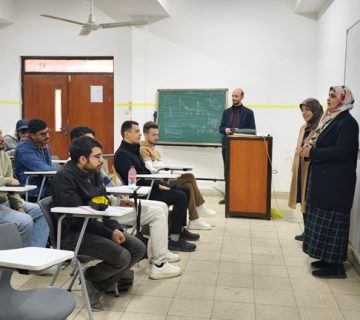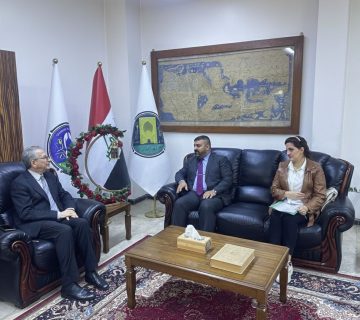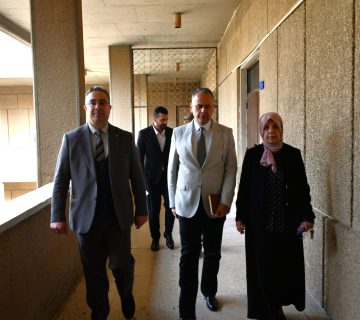Environmental Engineering Department at the College of Engineering, University of Baghdad, held PhD dissertation examination on Wednesday 30\8\2023 titled: “Coated iron-slag in the permeable reactive barrier for remediating of groundwater contaminated with lead and cadmium ions“By the student Teeba Saadi Hussein and supervised by Prof. Dr. Ayad Abdulhamza Faisal. The examination committee consisted of Prof. Dr. Shahlaa Ismail Ibrahim as Chairman, and the membership of Prof. Dr. Aamal Hamza Khalil, Prof. Dr. Abeer Ibrahim Musa, Assist. Prof. Dr. Haydar Mohammed Abdulhameed, and Assist. Prof. Dr. Hussein Jabbar Khadim. After conducting the public discussion and listening to the student’s defense, the dissertation was accepted. It was summarized as follows: The novel point of this study represents by synthesis new material for treating of aqueous solution laden with lead and cadmium ions through application of permeable reactive barrier (PRB) technique. This can achieve through utilizing of alum as cheapest coagulant, plaster kiln dust (PKD) wastes from gypsum industry, and cetyl trimethyl ammonium bromide (CTAB) surfactant in the preparation of nano-sized layered double hydroxide (LDH). The nanoparticles are consisted of aluminum from dissolution of alum, and calcium extracted from PKD in the existence of CTAB surfactant. The gel-solution of nanoparticles is co-precipitated on the iron slag byproduct to obtain new sorbent identified “iron-slag coated with (calcium / aluminum- cetyl trimethyl ammonium bromide) layered double hydroxide”. The outcomes proved that the area of slag surfaces was increased significantly from 0.49 to 10.21 m2/g due to the surfactant intercalation and precipitation of nanoparticles. The synthesis parameters require surfactant mass of 0.035 g/50 mL, pH 10, molar ratio of (calcium / aluminum) 2, and mass of slag 1 g/50 mL to remove highest percentage (>98%) of lead and cadmium ions. Batch tests proved that more than 99% of lead and cadmium can remove at time 60 min, initial pH 5 (Pb) and 7 (Cd), coated slag mass 0.5 g/50 mL, and speed 250 rpm for 50 mg/L initial metal concentration. Langmuir model is an ideal formula for representing the sorption data with highest sorption capacities of 20.277 and 14.504 mg/g for lead and cadmium ions respectively The measurements of kinetic tests were well followed the model of Pseudo second-order and; accordingly, the chemisorption mechanism will predominate the removal process. Model of intra-particle diffusion with characterization analyses demonstrate that the electrostatic attraction, hydrogen bonding and diffusion are major mechanisms required in the target metals removal onto the prepared sorbent. Characterization tests certified that the nanoparticles on the slag can play a prime role in the enhancement of metals sorption. In addition, the exhausted sorbent can be regenerated and its efficiency was not less than 83% for removal of lead and cadmium after 9 regeneration cycles Continuous column tests were conducted for duration not greater than 25 days. With a decrease in flow rate, pollutant inflow concentration, and an increase in sorbent mass, the coated slag-packed bed lasted significantly longer. Bohart-Adams, Thomas-BDST, Belter-Cussler-Hu, and Clark expressions are well simulated the measured breakthrough curves with determination coefficient (R2) > 0.99 and “sum of squared errors (SSE)” < 0.162. Also, the measurements signified that the hydraulic conductivities of packed sorbent were approximately stabilized at 2.7×10-2 cm/s which considers suitable for PRB.









